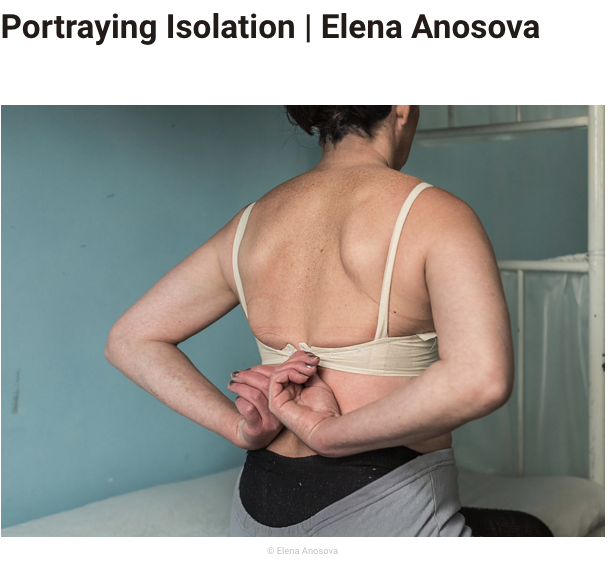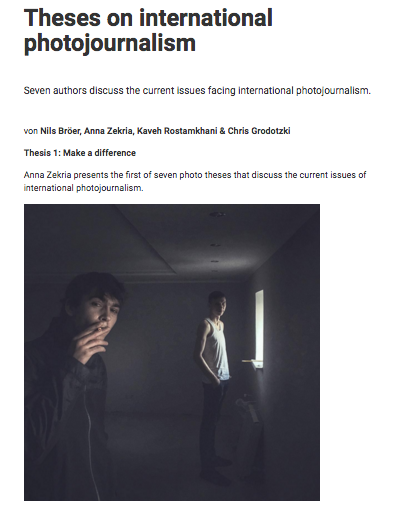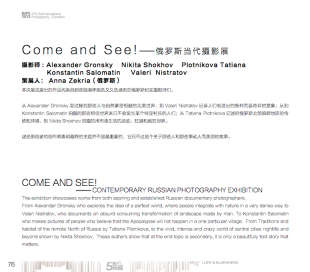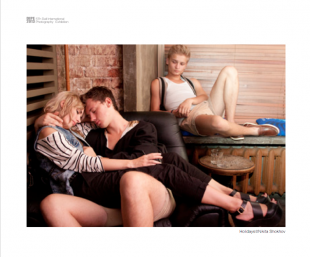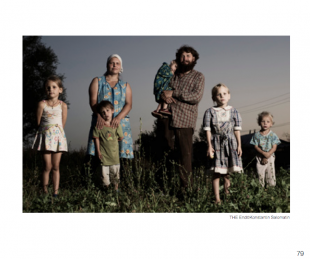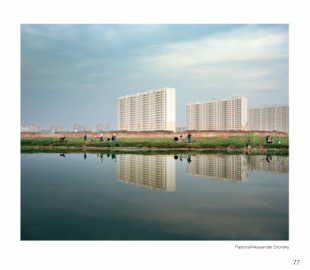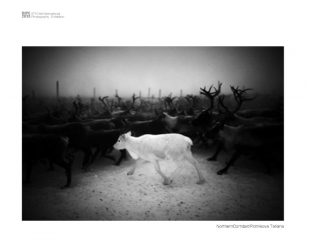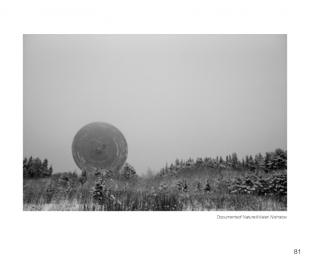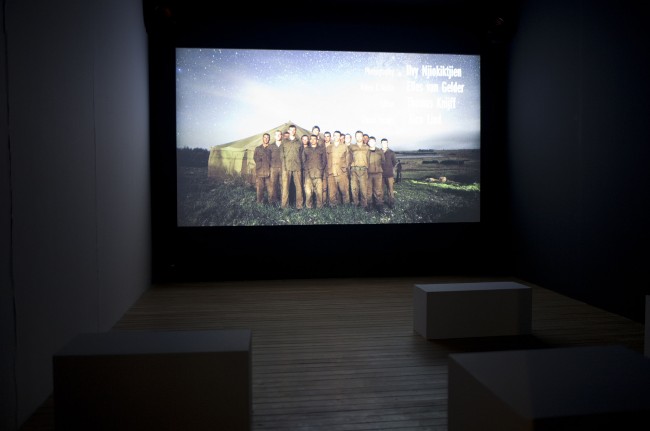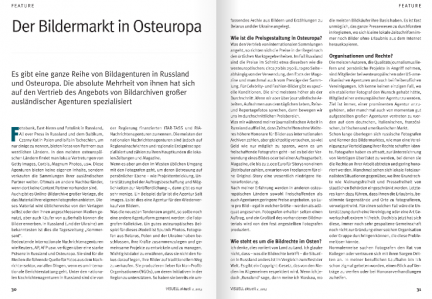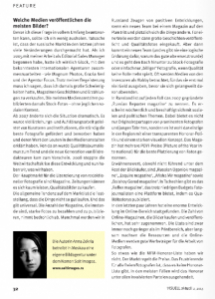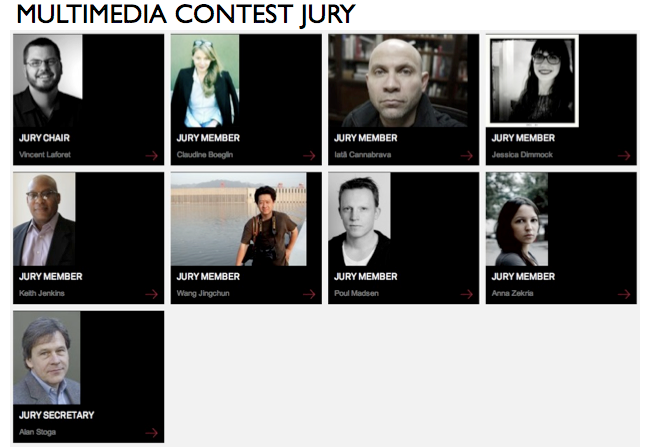Anna Zekria joins the discussion on international photojournalism
Thursday, December 15th, 2016Salt Images projection for the Rencontres d’Arles Night of the Year, Edition 2014
Tuesday, August 12th, 2014Night of the Year is the unmissable event of the famous Rencontres d’Arles festival (Arles, France). For this edition it took over the boulevard des Lices of the city of Arles, offering a photographic stroll where various photographic actors present the work they’ve produced in the past year on fourteen screens. Salt Images proudly presented works by Denis Sinyakov, Nikita Shokhov, Oksana Yushko and Anastasia Tsayder, curated by Anna Zekria.
Come and See! at Dali International photography festival
Tuesday, August 13th, 2013Stories of life: The Best of Multimedia Journalis at Red October, Moscow
Monday, May 13th, 2013Co-curated by Liza Faktor and Anna Zekria the exhibition showcases 10 projects as video projections and several web documentaries.
The projects created by photographers, journalists, editors and multimedia producers tell unique stories and at the same time address universal issues. From When the Floods Came by Gideon Mendel showing us some of the consequences of global warming to Superman by Zackary Canepari and Drea Cooper which explores the world of a man living the life of a superhero movie character to The Home Front by Marcus Yam and the New York Times, a heartbreaking feature on a single parent who is forced to part from his two infant sons, the show focused on the wonder of the visual in the world of storytelling.
Interview with Anna Zekria in VISUELL aktuell
Friday, March 15th, 2013Which are the biggest image agencies and archives in Russia and the other Eastern European countries?
There is a number of photography agencies in Russia and Eastern Europe. The absolute majority of them specialize in distribution of image archives from big foreign agencies. To name but a few – Fotobank, East-news and Fotolink in Russia, All over Press in Russia and Baltic States, Czarny Kot in Poland, Isifa in the Czech Republic etc. You will find local representatives of Getty images, Corbis, Magnum photos etc in almost every Eastern European country. These agencies do not produce any content they just resell archives from their partners abroad. Often agencies sell those archives to other neighboring countries if there is no representative there directly.
There are also online image archives of big publishing houses that carry the content produced by staff photographers. This content is generally used by the houses themselves or their syndications, yet images are available for external buyers as well. In Russia (and Ukraine) the most well-known is Kommersant.
Which are the biggest image-agencies and archives in Russia and the other Eastern European countries?
There is a number of photography agencies in Russia and Eastern Europe. The absolute majority of them specialize in distribution of image archives from big foreign agencies. To name but a few – Fotobank, East-news and Fotolink in Russia, All over Press in Russia and Baltic States , Czarny Kot in Poland, Isifa in Czech Republic etc. You will find local representatives of Getty images, Corbis, Magnum photos etc in almost every Eastern European country. These agencies do not produce any content they just resell archives from their partners abroad. Often agencies sell those archives to other neighboring countries if there is no representative there directly.
There are also online image archives of big publishing houses that carry the content produced by staff photographers. This content is generally used by the houses themselves or their syndications, yet images are available for external buyers as well. In Russia (and Ukraine) the most well-known is Kommersant.
Major news international agencies such as Reuters, AP, AFP etc have strong presence in Russia and Eastern Europe. They are the leading source of news photography for the media, especially when it comes to international news reporting. Among national news agencies in Russia we have government-funded ITAR-TASS and RIA news. However, most of the national news agencies specialize in local news and events and their main clients are local newspapers and magazines.
When it comes to agencies that follow the Western model of operation and deal with photographers on a personal level (develop their projects, look for assignments and publication opportunities), there are just a few of them. The agency Salt Images that I co-founded is an example of this model. We function more like personal agents rather than a reselling agency.
As for the latest tendencies, yet another form of agency should be mentioned. It is photographer collective. I think a really good Eastern European example of this model would be Sputnik Photos. A group of photographers from Belarus, Poland and Ukraine decided to unite their efforts and manage their projects together. What is important is that they do not focus on selling their images in traditional ways. They rather find non-governmental funders (NGOs) to support their initiatives in the region. They have already produced a comprehensive survey on Belarus and Ukraine.
How are the prices when the images are published in Eastern Europe?
In case of international archive distribution, prices are normally determined locally by agency representatives who have knowledge of the local market budgets. In case of Russia prices would be about the same compared to average Western European fees. For international archives the average is 70–250 EUR per page depending on the usage, magazine budgets and sometimes even prestige of the archive. There are special fees for celebrity and fashion images. These are usually higher than the average. However, if we talk about journalistic work, daily life, travel and reportage the fees would be within the price range.
One of the observations I made while working with editorial market in Russia is that magazines would easily pay high fees for international archive images, but try to save as much money as possible when it comes to freelancers – be it image usage or commissioned work. Magazines that would pay up to 2000 EUR for features bought from a distributor expect freelances to produce original stories for much lower budgets.
In my experience, smaller fees are offered to both freelance and agencies in other countries of Eastern Europe. Fee of 50 EUR per image regardless of the space is considered very good. Photographers are rarely commissioned and a large share of content is produced by staff photographers.
How is the situation with the rights for the images in Eastern Europe?
I suppose it varies from country to country. I do not think that the situation with rights in Russia is much different when compared to the rest of the World. There is a copyright law which is respected by media in general. However, when I say Russia I mean Moscow, where the majority of image buyers are based. It is almost impossible to keep track of press in the regions where small local magazines still use images taken from the web without legally licensing it.
How are photographers organised in Eastern Europe? Are there any organisations that will help the photographers to fight for there rights or the prices?
Most of the authors that produce quality journalism and personal projects are members of Western European/US agencies or freelancers. I have not heard of a case when an established photographer would desire to become a member of an agency from Eastern Europe. The goal is always to join a prominent agency, or sometimes find great local representatives for each of the currently viable markets: Germany, Italy, France, UK and US.
There has always been much talking among Russian photographers and industry specialists about creating some kind of union to defend their rights. Photographers are often fed up with being tricked into signing contracts that make them refuse the right for their work and low fees. Sometimes local photojournalists face situations where their basic rights such as freedom of speech and freedom of press are infringed by State authorities. The latter may deny photographers permission to shoot certain objects and places. In such cases the support from some kind of a union would be extremely useful. Still, the community while being extremely segmentary has never managed to unite into a group or organization that would handle these issues.
Usually photographers just seek each other’s advice or approach trusted third parties with this kind of issues. During my professional carrier I’ve been asked to help with negotiating prices or take a look at contracts numerous times.
Which media, newspapaer, magazine are printing, showing (bying) the most images?
To fully answer this question, a little introduction should be made. As a matter of fact, the Russian market has gone through a lot of changes within the past few years. When I started to work as an editorial sales manager in 2005, I was really lucky to work with the most prominent international agencies straight ahead e.g. Magnum photos, Grazia Neri and Agentur Focus. No matter how excited I was, I must say that at that time I faced huge difficulties trying to sell stories and features to magazines. Most media institutions tended to publish stock images with no social context whatsoever.
By the year 2007 the situation has changed dramatically. There was a lot of education done by curators and institutions that would constantly promote the best photography and explain its value to people at media houses. At one point quality journalism has become a trend. The whole new generation of photo editors has emerged. In 2008 the global economic crisis hindered this development and now we have what we have.
The main market for editorial image licensing are magazines. Newspapers barely can afford to purchase quality images. The common tendency in the markets in general is that things are not going too well. And this tendency is universal — the number of magazines capable to publish and pay for strong visual content is critically decreasing. In Russia we witness positive episodes from time to time when a new team comes to a magazine and suddenly things start to change. For some time they would publish great stories and pay for quality images. But then comes a new team (there is never any logical explanation why the good old one is replaced) and it shifts down to stock photography or simply ‘cheap’ photography when quality does not matter. Often media are just treated like hobbies by investors who they are ready to spend big budgets until they simply get bored.
In Russia I would definitely name Russian Reporter magazine (since 2007). It is a weekly social and political magazine than not only produces original reportage both with prominent photographers and young talent but also is about the only one in the region with transparent honorary politics and strong visual concept. Magazine has won several POYi (Picture of the Year International) awards for best placement of images.
There is no strong leader among the rest of image buyers but Russian Ogoniok magazine, Esquire magazine, Afisha Mir magazine, Bolshoy Gorod magazine are worth mentioning. In Czech republic there is a Reflex magazine that despite low budgets give a platform for photojournalists by publishing quality stories.
Within the last few years there has been a huge development in online media. The number of online magazines that would purchase and feature photography has dramatically increased. The budgets are still much less than print, but slowly online resources become great media to showcase the photographers’ work.
Are there organisations which are charging honorars from magazines or users who are using images? In germany we have e.g. http://www.bildkunst.de/html/index_e.html
No, there is no such organization. Although if it existed it could be very helpful in monitoring copyright issues in regional press, for example.
Are there price lists in russia and Eastern Europe for image? We in Germany have e.g. the MFM List.
We have no lists like the MFM List. Everything is defined by the rules of market. The frustrating thing for freelancers is the absence of any rate guides that would give them a strong idea about magazines’ fees. In most cases those are subject to market negotiations between all parties involved.
New short feature: The End by Konstantin Salomatin
Thursday, September 13th, 2012Check out new short feature by Konstantin Salomatin. Editing and production by Max Sergeev, Anna Zekria and Maria Zakharova.
Occupy Abay by Olga Kravets
Tuesday, August 14th, 2012Check out new short feature by Olga Kravets. Edited by Anna Zekria and Max Sergeev. Produced by Salt Images.
World Press Photo announces 2012 multimedia contest judges
Friday, January 13th, 2012We are proud to announce that Anna Zekria will be judging 2012 World Press Photo Multimedia contest.
World Press Photo has held an annual press photography contest since 1955. As part of the organization’s mission to encourage high professional standards in photojournalism and to support professional press photography in all its aspects, World Press Photo decided to initiate a new contest for multimedia productions last year.

